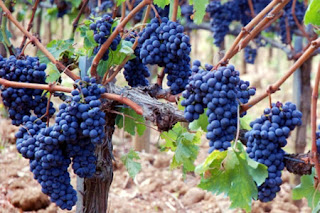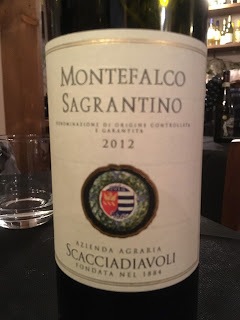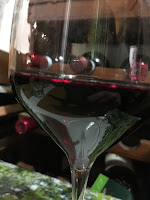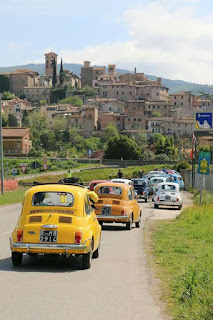Tuscany is the King of red wines with it's Chianti, Brunello and Super Tuscan. But Umbria has a secret weapon; Sagrantino di Montefalco!
Montefalco is a hill town in Umbria, Italy, a Region that borders Tuscany. Unlike Tuscany, Umbria is much more Mountainous with the Apennine range running through the East of this Region, creating a colder climate for grape growing. Montefalco and it's neighbouring towns like Bevagna 7 km away grow Sagrantino grapes that become the famous Sagrantino di Montefalco.
 |
| Sagrantino Grapes |
Sagrantino has been made in this region of Italy for hundreds of years. In fact, there have been grapes growing in this area since Roman times; we know this because the Romans wrote down EVERYTHING. Pliny the Elder (same dude who wrote about the eruption of Mount Vesuvius: see blog) wrote of "Itrida" and "Piceno" grape varieties in this area. "Picenum" is a Greek word for the Roman territory that is now basically the Marche Region of Italy. Here's the deal, though: the Sagrantino grape does not share any commonalities with any other grape variety grown in central Italy. There is some speculation that the Greeks brought this grape variety to Umbria via the indigenous Piceni people that were famous traders, and made a brisk trade with the Greeks.
 |
| Can I Get You Guys Some Wine? |
The word "Sagrantino" comes from Latin roots: "Sacer," meaning "sacred," and this wine was used as a sacramental wine for the altar. The Italian word "Sagra" from the same Latin root means celebration and used to refer to religious ceremonies in church and homes. This is probably why Sagrantino grapes were grown INSIDE the city walls of Montefalco, keeping the vines preserved over the years; the Holy Vines from the Holy Lands needed to be protected to make the Holy Wine.
There are also theories out there that St. Francis's disciples brought this grape variety back from the Holy Lands in the 1200s and that they are the ones responsible for creating the Sagrantino wine. Well then, bless them thoroughly! The first mention of Sagrantino grapes being cultivated by monks was 1549, and these guys really knew their stuff. The monks realized there was a very high sugar content in these grapes and that they had a real rot-resistant nature. The Sagrantino grapes were tiny, and there was not much of yield compared to other varieties. But the monks were clever winos and knew exactly what to do with this grape to produce a fantastic product.
The original version of Sagrantino the monks made was a sweet wine in the passito style. "Passito" is a style of wine that is known as "straw wine" or "raisin wine." It involves drying the grapes for 2 months before pressing. In the old days, the grapes were dried on straw so that the grapes are halfway to being raisins. This is an ancient technique that was recorded by the Ancient Greeks as far back as 800 B.C.E. We would call Passito a dessert wine, and the traditional Sagrantino di Montefalco Passito is still popular and sold by many vintners today.
See, the monks also knew that the Sagrantino grapes have a high tannin content, which is not easy to balance. So drying out the grapes balanced the tannins by concentrating their sugar content....and made a VERY delicious wine; a smooth, sweet, nectar of the angels. So good in fact, it became a bit of a legend in its own time.
 |
| Mommy's Little Helper |
This Sagrantino wine became THE wine in the local churches of Umbria for Holy Communion and other religious ceremonies. Local farmers also drank this Sacred Wine on religious holidays such as Christmas and Easter. The wine was even used for spiritual healing. There had been a local priest in the Middle Ages that specialized in exorcisms using Sagrantino wine. In fact, he exorcised the demons out of a local woman by getting her to drink a bottle (or three) of Sagrantino wine. I bet you money she was the mother of multiple teenagers. I wonder if you can get a prescription for Sagrantino?
This is where vintner Azienda Agaria gets his label name "Scacciadiavoli." "Scacciare" in Italian means "to banish" and "Diavoli," is you know, The Devil. Nowadays, Sagrantino is made "secco" or dry. It is a DOCG wine since 1979 made out of 100% Sagrantino grapes. The wine must be aged for a minimum of 37 months; 12 of those must be in Oak barrels. To me, it tastes like: berry.spice.raisin.smoke. Yum!
 |
| Glass O'Vitamins! |
Salute in Italian is equivalent to "cheers" when drinking wine, it literally means "to your health." These Italians KNOW a few THINGS!!!



No comments:
Post a Comment